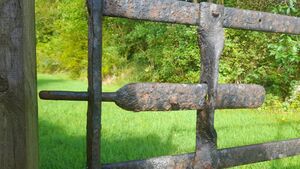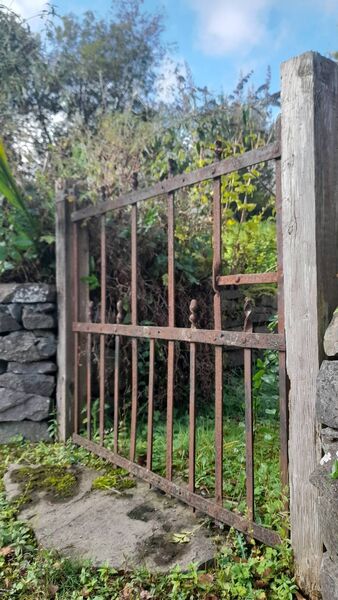The fine work of the blacksmith still lives on

An example of the careful craftsmanship of the blacksmith's gates, which have outlasted several generations. Picture: Pat McCarrick
An item of old that is to be found discarded in the overgrown hedges and ditches of the Ox Mountains is the blacksmith’s gate. These are not gates once owned by blacksmiths, but gates once made by blacksmiths.
Virtually indestructible, these gates were handmade and apart from a light coating of rust, most of them are as sound as the day they were made – most of them, over 100 years ago. Such gates were made in the unique style of a region and often with the distinctive touch of the local blacksmith.
A blacksmith is a metalsmith who creates objects primarily from wrought iron or steel, but sometimes from other metals, by forging the metal, using tools to hammer, bend, and cut. In times gone by, blacksmiths produced objects such as gates, grilles, railings, tools, agricultural implements and even weapons.
The place where a blacksmith works is generally referred to as a forge. In former times, the blacksmith had a general knowledge of how to make and repair many things, from horseshoes to lengths of chain. Dún na Sí Amenity and Heritage Park in Moate, Co Westmeath, has this to say about their replica blacksmith’s forge.
When researching the history of metalworking and blacksmithing, I came across the following account provided by Craft Master Elite, a US company that runs an online shop providing all sorts for the blacksmiths of today. Their information piece, , is very interesting and takes us right back to the Iron Age.
The introduction of charcoal as a forging fuel was one of the most significant advancements of ancient blacksmithing. Their use of charcoal allowed them to hone smithing processes and forge more powerful items.
Blacksmiths were an everyday necessity during the Medieval Ages. Due to the high demand for stronger weapons, armour and tool, every town or village had at least one blacksmith. Specialised smiths also crafted specific items such as locks, silverware, nails, and chains. During this era, charcoal was the fuel of choice. Coal, which is a typical modern fuel, didn’t become readily available until the nineteenth century.

I love this definition from Webster Dictionary; . Wrought iron is an iron alloy with a very low carbon content, making is ‘softer’ than the more brittle cast iron. Wrought iron is tough, malleable, corrosion-resistant, and easily forge-welded. This was the iron of choice for blacksmiths everywhere.
I was only in a real blacksmith’s forge once, when I was a child. It was a dark, hidden place at the end of a long lane. The man who owned it was continuing a long tradition and mostly used the forge for his own use. He was a milk carter and had regular need to keep his cart horse shod.
I since discovered that forges needed to be dark as it allowed the blacksmith to read the iron better. Blacksmiths knew their iron and knew to strike when the iron was… not so much hot, but the right colour – red, orange, yellow, or white hot – depending on the job at hand.
Of all the things that blacksmiths created here in Ireland, surely their gates hold supreme. I have a burning desire to save the last of these gates and honour them. The hedges and gaps of the Ox Mountains and the surrounding countryside still contain them. Some have been lost and more have been trampled by huge tractors too large to negotiate the openings once secured by such gates, but as I walk a loop of five miles close to my home, I see several every day – some still in use. I have one myself. It was made from wheel iron, made in its day to contain a bull. This particular gate will outlive all my future generations.
I have sent this article to the Museum of Country Life in Castlebar with the intention of arousing their interest in collecting and displaying some of the best examples of old blacksmith’s gates from the counties of Sligo and Mayo. Maybe someday we will see these beautiful gates, and the gifted men who made them, honoured in a permanent exhibition locally.
There are still a few blacksmiths to be found in Ireland; mostly artists and elite crafts people. Their work is far removed from shoeing cart horses or making loys for tilling the soil. I am sure many of the old blacksmiths who learned their trade from their fathers and grandfathers would be amused to know that you can now go to college and qualify as a blacksmith.
Limerick College of Further Education (LCFE) in Cappamore is an accredited blacksmith training college with City & Guilds Level full-time courses and a selection of beginner and intermediate part-time evening classes. The college is fully kitted out with eight working forges, white boards, drawing boards and all the in-house facilities expected for today's learners. As of 2022, all courses are now fully funded at the college. Contact LCFE on 061-381272 for further enquiries. You could end up reviving the tradition of making wrought iron gates – the blacksmith’s gate.






